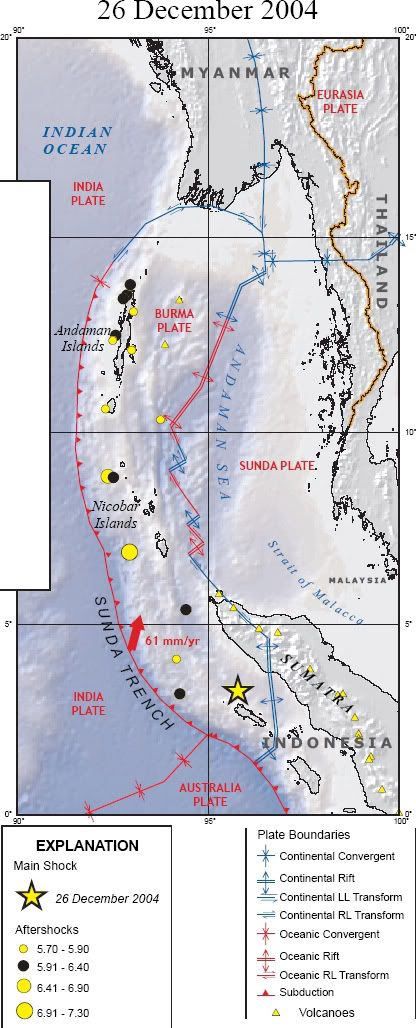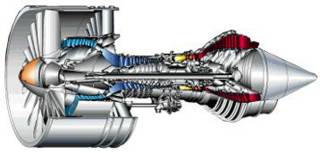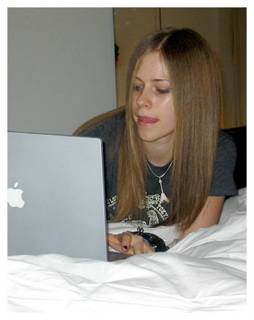Poisoned legends started to insurrect when the doomed sky refused to shine. Dathana blog here in the quest for the key of sky. -::::....:::::- (ၿငိမ္းခ်မ္းရာ) "Nyein Chan Yar" means Sanctuary or Place of Serenity.
Friday, December 31, 2004
Netcraft anti-phishing
Tuesday, December 28, 2004
How tectonic plates moved in Sumatra earthquake

This figure show how tectonic plates moved in Sumatra earthquake on December 26, 2004, 07:58:50 local time. (taken from this pdf.)
Saturday, December 11, 2004
AI: Alice bot
dathana : do you have knowledge?
ALICE: I contain an immense knowledge base.
dathana : example
ALICE: For example, Do you believe the strong protect the weak?
dathana : how do you know?
ALICE: Deductive reasoning.
dathana : sounds cool
ALICE: Yes it sounds like it to me too,.
If you ask her too much questions, she would retort you with a question. Sometimes she can give you good suggestions such as referring you to look in open directory.
You can also get your own bot for free. You can train your bot adding more category, knowledge and so on.
I wonder what if the search engines like Google combine with ALICE-bot and have natural language search feature. Isn’t it possible?
Or add the whole encyclopedia to her knowledge base. And make a handheld device with voice recognition system so that we will be able to bring that device anywhere and ask anything we want to know.
Monday, December 06, 2004
Thursday, December 02, 2004
My December
My December
Artist: Linkin Park
This is my December this is my time of the year
This is my December this is all so clear
This is my December this is my snow covered home
This is my December this is me alone
And I
Just wish that i didnt feel like theres something i missed
Take back all the things i said to make you feel like that
And I
Just wish that i didnt feel like theres something i missed
Take back all the things i ever said
And I..
Give it all away just to have somwhere to go to
Give it all away to have someone to come home to
This is my December these are my snow covered trees
This is me pretending this is all i need
And I
Just wish that i didnt feel like theres something i missed
Take back the things i said to make you feel that
And I
Just wish that i didnt feel like theres something i missed
Take back all the things i ever said
And I
Give it all away to have somewhere to go to
Give it all away to have someone to come home to
Sunday, November 21, 2004
Min Ko Naing freed
Student Leader Freed By Kyaw Zwa Moe November 20, 2004
Burma’s most prominent student leader was freed on Friday after being detained for nearly 16 years in jail, a family member said. Paw Oo Tun, known as Min Ko Naing, or “Conqueror of Kings,” arrived last night at his home, Rangoon , from Sittwe jail, 350 miles (560 km) northwest of Rangoon . Min Ko Naing "I feel as if I have awoken from dreamland and I've just started to open my eyes," Min Ko Naing told Reuters news agency at his home after being freed from prison. The 42-year-old former student leader is in good health, except that he has a low fever. He is now resting, a family source said. Min Ko Naing and 20 other political prisoners were released from prisons across the country on Friday, after the military government announced 3,937 prisoners would be released since they had been sentenced improperly by the National Intelligence Bureau, or NIB. The powerful NIB was dissolved last month after the military junta sacked Prime Minister and intelligence chief Gen Khin Nyunt. The charismatic student leader was arrested by the Military Intelligence in March 1989 for his leadership role in the 1988 democracy uprising. During the uprising, Min Ko Naing became chairman of the All Burma Federation of Students’ Unions, which is banned in Burma . The student leader was sentenced to 20 years imprisonment, but later reduced to 10 years. Despite having already completed his sentence in 1999, the authorities continued to detain him under Article 10 (a) of the State Protection Act until his release. Friends of Min Ko Naing and former student activists welcomed the news. They said it is good news for Burmese activists and campaign groups who have been campaigning for the release of Min Ko Naing. While people are happy to learn the release of political prisoners they maintained cautious optimism. “They release him (Min Ko Naing) today and they can put him back in jail tomorrow,” said a Burmese activist in Rangoon . Political observers are doubtful that the mass release of prisoners will lead to political reconciliation.
Saturday, November 20, 2004
X34A, SMART-1, SX-8, Blue Gene/L
The world got new things and new speed records these days.
X34A

That was X34A which already aimed to reach Mach 7 to 10. Previously it reached Mach 7 in 2004 March. Again, on 16th of this month (Nov 16, 2004) it
made its Mach 10 flight
successfully. You know what; it was two miles per second. One important thing is that it was only experimental flight. Scram jet won’t be able to take part in passenger flights. In my opinion, saying to use it in passenger flight is misleading. It might be useful to use in combination with rocket boosters for space shuttle to reduce fuel consumption and hence lighter spacecrafts.
Link
Ion propulsion rocket gets to the Moon
Washington, DC, Nov. 15 (UPI) -- A European Space Agency rocket entered moon orbit Monday in a unique mission using a pioneering power plant.
The s-called SMART-1 spacecraft blasted off from Kourou, French Guiana, Sept. 27, 2003, on top of an Ariane 5 rocket, the Washington Post reported.
Since then its ion propulsion engine has been slowly moving the spacecraft by expelling positively charged atoms, or ions, of the gas xenon, accelerated by an electrical field inside the spacecraft's engine.
The engine does not combust fuel; rather it splits atoms with electricity to get ions, accelerates them at high speed, and then ejects them, driving the spacecraft forward. SMART-1 generates its electricity by converting sunlight with outsize solar arrays that give the spacecraft a 45-foot wingspan.
Although ion propulsion does not generate much thrust, nothing slows it down in space so it constantly accelerates. Now that it has entered Moon orbit it will use the ion engine to slow down and study the lunar surface.
link
Supercomputers.
Previously, NEC’s Earth Simulator was the fastest with 35.86 teraflops.
In September IBM said its Blue Gene/L supercomputer had surpassed NEC's Earth Simulator to become the world's most powerful supercomputer. IBM's Blue Gene/L is capable of a sustained data processing speed of
36.01 teraflops.
In October, NEC claimed its SX-8 is the most powerful 'vector-type' supercomputer, with a sustainable data processing speed well beyond IBM's recently unveiled Blue Gene/L supercomputer. NEC said its newest SX series model has a peak processing speed of 65 teraflops and a sustainable performance of roughly 90 percent that speed or
58.5 teraflops.
The NEC and IBM supercomputers are different in structure. NEC says it’s SX-8, because of its vector architecture, "delivers much higher sustained performance than scalar supercomputers" like IBM's Blue Gene/L.
Link
After that IBM Blue Gene/L has managed speeds of 70.72 teraflops in November.
 Supercomputer
SX-8 Series (Multi-Node System)"
Supercomputer
SX-8 Series (Multi-Node System)"
Friday, November 05, 2004
Let's double click
Some of my friends always double-click. Yes. They always double-click everything such as web links and so on. I cannot stop them. I told them that was single click, not double but they used to retort, “What would happen!” May be they think it is sure to work if they always double click whatever so that they could reduce one instruction set to be stored in brain.
System developers already knew about those people. Microsoftie Raymond wrote while explaining mouse clicks.
Because many users double-click everything. Here are some examples of where the "delayed action to avoid the second click" can be seen:
The context menu that appears for taskbar notification icons. If the context menu appeared immediately upon the first click, then the second click would dismiss the context menu, leaving the user confused. "I clicked and something happened and then it went away." (Users don't say "I double-clicked"; they just say that they clicked. Double-click is the only thing they know how to do, so they just call it "click". For the same reason you don't say "I drove my blue car" if you have only one car.) link
Monday, October 18, 2004
What will happen in next 10 years?!
Last week, when Bill Gates met the students at Berkeley, he said, “I think a lot of the breakthroughs will be made by people who were trained in biology and computer science.”
And about four months ago Microsoft has been granted a patent on power networking using the human body itself. So what will our new world’s technology trends shifting to…
A slashdotter highlighted an interview with Ray Kurzweil, author and inventor.
Ray Kurzweil predicted what will the world and technology become in next 10 years. He pointed out the importance of biotechnology. And how nanobots, computers will be implanted in our body.
The interesting parts he said are:
Q: Speaking of new models, what will be different about the IT department 10 years from now?
A: Let's look at a few trends. A lot of the equipment that IT departments concern themselves with now—routers and servers—will all be gone. There won't be computers on desks. We'll eliminate most of that clutter, certainly by the end of this decade. Technology will be very mobile; it'll be so small that it'll be virtually invisible. Everybody will be online. Images will be written right to our retinas. We'll have very high-speed bandwidth connections at all times. The computing substrate will be everywhere.
Q: What about people? What will we be like? What will we be doing?
A:…
…
Well, soon computers will be inside us. Within one to two decades, we will be able to place nonbiological intelligence inside us, noninvasively.
By the 2020s we will be placing millions or billions of nanobots—blood cell-size devices—inside our bloodstream to travel into our brains and interact with our neurons. We will be extending our cognitive capability directly through this intimate merger of biology with machines.
Right now, there's a restricted architecture to the way our brains work. The brain uses electrochemical signaling for information processing, and that's a million times slower than electronic circuits. You can make only about 100 trillion connections in there. That may seem like a big number, but the way in which we store information is inefficient, so that a master of an area of knowledge can really remember only about 100,000 chunks of knowledge. If you use Google, you can already see the power of what machines can do. In the future, we will be able to expand the 100 trillion connections we have with new, virtual ones. Once nonbiological intelligence gets a foothold in our brains, it will grow exponentially. As we get to the 2030s, human beings will have biological brains enhanced with more powerful nonbiological thought processes.
So the answer to your question is, if we remain unenhanced, if you just had machines developing on a distinct track, they would surpass humans. But that's not what's happening. We are merging.
After that the topic moves to the medicine, bioengineering, anti aging reverse aging…
Q:You look like you're in good shape.
A:Well, I take this very seriously. I'm very aggressive in terms of reversing aging, or slowing down aging. I recently took a biological aging test with my health collaborator (who is also my coauthor), and based on 20 different tests—memory and sensory acuity and response times—it had me at age 40. I'm 56.
What do you do to slow the aging process?
I eat a certain diet. I take 250 supplements a day. I'm really reprogramming my biochemistry. A lot of people think it's good to be natural. I don't think it's good because biological evolution is not on our side.
…
…
Well, ultimately, there's going to be very little difference between a guy who's 120 and a guy who's 30.
The interview is way too interesting. Read more
here.
Monday, October 04, 2004
TIMEasia Magazine: Asia's Heroes - Reader Poll
For her steadiness and her steadfast belief in the powers of democracy and peaceful protest, 40.4% (37,617 votes)of voters nominated Aung San Suu Kyi as Asia's Online Hero for 2004.
Saturday, September 25, 2004
photovoltaics, Bands back Burma activist Suu Kyi
Eat your spinach," Mom used to say. "It will make your
muscles grow, power your laptop and recharge your cell phone... " OK. So
nobody's Mom said those last two things.
Researchers at the Massachusetts Institute of Technology say they have
used spinach to harness a plant's ability to convert sunlight into energy for
the first time, creating a device that may one day power laptops, mobile phones
and more.
links:

The leader of Burma's opposition party has been held under house arrest by the ruling military junta for a year.
Eric Clapton, U2, Coldplay, Sting, Avril Lavigne and Travis will also feature on the 27-track album, the proceeds of which will go to the US Campaign for Burma.
The album, called For the Lady: Dedicated to freeing Aung San Suu Kyi, will be released by Rhino Records on 26 October.Michael Stipe, lead singer of REM, said: "Her dedication, resolve, courage and patience are the mark of a leader. We stand tall for her as she will again stand tall for herself."
 REM's Michael Stipe praised Suu Kyi's "resolve and courage"
REM's Michael Stipe praised Suu Kyi's "resolve and courage"
|
Clapton said: "Anytime anyone in Burma listens to my music, I want them to
know that they are listening to an artist that supports their freedom."
The album will feature exclusive tracks by REM, U2, Pearl Jam, Damien Rice and Tom Morello's The Nightwatchman, as well as
previously released songs by Avril Lavigne, Coldplay and Travis.
Link2:
Sunday, September 05, 2004
Monday, August 16, 2004
Saturday, August 14, 2004
Printing cells using Inkjet Printers
Inkjet Printers Offer Biology Breakthrough
Emily C Kumler, Medill News Service
If you think injecting ink into a printer cartridge might damage your printer, try filling it with animal cells. That's what they're doing at Clemson University in Clemson, South Carolina, these days. In the name of science, researchers have developed a way to print sheets of solid animal tissue by filling Hewlett-Packard and Canon inkjet cartridges with animal cells, or "bio-ink."Using basic design software, often AutoCAD, scientists like Thomas Boland, an assistant professor of bioengineering, are designing and generating tissue that could someday save heart patients who need new cardiac tissue.
"We've created cardiac tissue successfully," Boland says. "It actually beats in the petri dish."
Inspired Alternative
Boland says that just as blending primary colors results in new colors, so does printing different cells create new tissue.
The idea to use common computer printers occurred when a student was conducting a common micro-patent printing, which is done by hand. Boland realized his student was having difficulty repeating the results and the printing process was time-consuming.
"I went to the lab to see what we could use," he says. "The computer printers were printing patterns in liquid drops." That gave him the inspiration to try what he calls "protein printing."
They started by printing proteins and have moved to printing cells.
Boland admits that people thought the idea was far-fetched at first, but the more they learned about printers, the more sense it made.
"Initially, heat was the big concern, but then people learned that these printers raise the temperature by not more than 10 degrees, which is about body temperature," he says. "People either didn't understand how the printers worked, or if they understood the printers they didn't know about biology."
The group gets most of its printers from the university's surplus stock.
"We can strip them down in less than an hour, and we usually buy new cartridges. The whole thing is very cheap," he adds.
Next: New Organs?
The Clemson group says it has had success in re-creating bone tissue in mice. The scientists are now working on embryos and moving to in vitro tissue implanting--a more complicated process because of potential contamination. The group's ultimate goal is to print organs.
The scientists say that the printing could allow doctors to study, scan, and duplicate exactly what a patient needs and to develop custom treatments.
Soon, human tissue could be printed so researchers could test medications for their effect on the tissue, Boland says.
"In a couple of years this could be used on humans, after FDA approval," he says.
While Hewlett-Packard is following the scientists' research, Canon has already formed its own organ-printing project in Japan.
Boland says he is amazed at how easily the printer works and how successful the group has been. "This is not a fluke," he says. "It will come to market eventually."
Source





